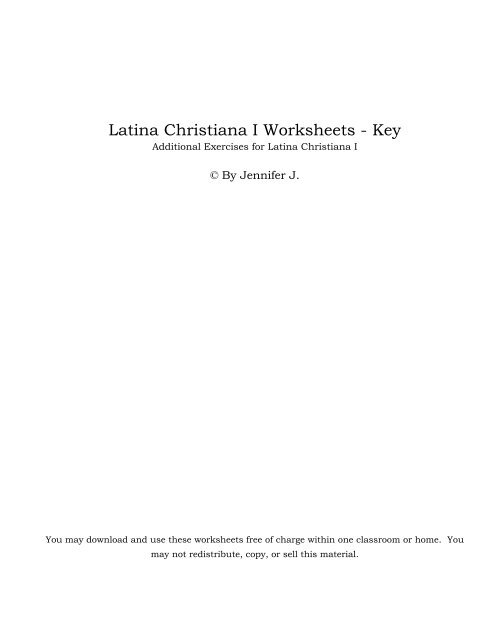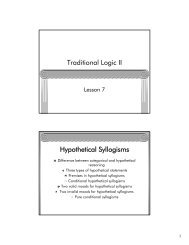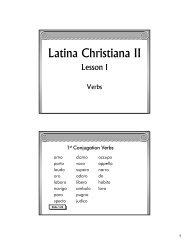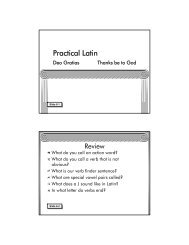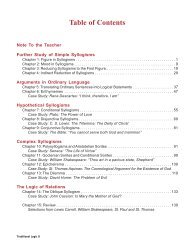Nota Bene - Memoria Press
Nota Bene - Memoria Press
Nota Bene - Memoria Press
You also want an ePaper? Increase the reach of your titles
YUMPU automatically turns print PDFs into web optimized ePapers that Google loves.
Latina Christiana I Worksheets - Key<br />
Additional Exercises for Latina Christiana I<br />
© By Jennifer J.<br />
You may download and use these worksheets free of charge within one classroom or home. You<br />
may not redistribute, copy, or sell this material.
<strong>Nota</strong> <strong>Bene</strong><br />
Terminology: Personal Endings, Conjugation of Verbs, 1 st Person, 2 nd Person, 3 rd Person – Singular & Plural<br />
Number of Tense Endings - 6<br />
Characteristic of First Conjugation Verbs – stem vowel “a”<br />
Worksheet 1 (covering Lessons 1, 2)<br />
A. Translate the following from English into Latin.<br />
1. You carry. PORTAS<br />
2. They pray. ORANT<br />
3. We prepare. PARAMUS<br />
4. She sails. NAVIGAT<br />
5. He works. LABORAT<br />
6. You (pl) love. AMATIS<br />
7. I look at. SPECTO<br />
B. Translate the following Latin into English.<br />
1. Portamus. WE CARRY<br />
2. Laborant. THEY WORK<br />
3. Oro. I PRAY<br />
4. Spectamus. WE LOOK AT OR WATCH<br />
5. Amat! HE LOVES<br />
6. Navigatis. YOU (PL) SAIL.<br />
7. Paras. YOU (S) PREPARE<br />
1. What is a noun? A PERSON, PLACE, THING OR IDEA<br />
2. What is a verb? A WORD SHOWING ACTION<br />
3. To which kind of word is a personal ending added? VERB<br />
4. What is the 2 nd Person Plural ending for the First Conjugation? –TIS<br />
What is its translation? YOU (PL) or (YOU ALL/Y’ALL)
<strong>Nota</strong> <strong>Bene</strong><br />
Terminology: Conjugating Verbs – personal endings; Noun declensions – case endings<br />
Translating Present Tense – 3 ways: Amo: I love, I am loving, I do love.<br />
Worksheet 2 (covering Lessons 3, 4)<br />
1. How many endings are there for each verb tense? 6<br />
2. What is the characteristic feature of First Conjugation verbs? THE STEM VOWEL ‘A’<br />
3. What is the First Person Singular ending for First Conjugation verbs? –O<br />
4. What is the Third Person Plural ending for First Conjugation verbs? –NT<br />
5. The pronoun “we” is what Person and Number? FIRST PERSON, PLURAL<br />
Translate from English to Latin<br />
1. You (all) do shout! CLAMATIS<br />
2. We look at. SPECTAMUS<br />
3. They are preparing. PARANT<br />
4. You prepare. PARAS.<br />
5. He is overcoming. SUPERAT<br />
6. They do sail. NAVIGANT<br />
7. We are praying. ORAMUS<br />
8. He is. EST<br />
9. They are. SUNT<br />
10. They love. AMANT
<strong>Nota</strong> <strong>Bene</strong><br />
Names of Cases: NGDAA<br />
Number of Genders: 3 – feminine, masculine, neuter<br />
Worksheet 3 (covering Lessons 5, Review 1)<br />
1. What are the suffixes on the end of Latin nouns called? CASE ENDINGS<br />
2. How many named cases are there for each noun? 5<br />
3. What are the names of these cases? NOMINATIVE, GENITIVE, DATIVE, ACCUSATIVE, ABLATIVE<br />
4. How many genders are there for Latin nouns? 3<br />
Translate from English to Latin:<br />
1. We are freeing. LIBERAMUS<br />
2. You (pl) adore. ADORATIS<br />
3. They do walk. AMBULANT<br />
4. I am praising. LAUDO<br />
5. You (s) are preparing. PARAS<br />
6. You (pl) are looking at. SPECTATIS<br />
7. He shouts! CLAMAT<br />
8. She is working. LABORAT
<strong>Nota</strong> <strong>Bene</strong><br />
Nominative Case: Subject of sentence.<br />
Teach Direct Object Case accusative case. What is a direct object? Receives the action of the verb in a<br />
sentence. In Latin, that noun is changed to the Accusative Case. Example: He loves Rome. Amat Romam. Usually the<br />
verb stands last in a Latin sentence: Romam amat.<br />
Worksheet 4 (covering Lessons 6, 7)<br />
1. How many tense endings are there for a Latin verb? 6 (3s/3pl)<br />
2. How many named declensions are there for a Latin noun? 5<br />
3. In what order are the noun declensions listed? NGDAA<br />
4. Which noun case is used for the “subject” of a sentence? NOMINATIVE<br />
Translate from Latin to English.<br />
1. Judicamus. WE JUDGE, CONSIDER<br />
2. Pugnat. HE FIGHTS<br />
3. Pugnant. THEY FIGHT<br />
4. Occupatis. YOU (pl) SEIZE<br />
5. Occupas. YOU (s) SEIZE<br />
6. Judicat. HE JUDGES<br />
The Accusative case in noun declensions is used as a direct object in a sentence. This is so the reader knows who received<br />
the action of the verb.<br />
Give the Accusative case, Singular form for the following Feminine nouns:<br />
1. Maria MARIAM 4. puella PUELLAM 7. Italia ITALIAM<br />
2. unda UNDAM 5. Roma ROMAM 8. femina FEMINAM<br />
3. silva SILVAM 6. terra TERRAM 9. vita VITAM
<strong>Nota</strong> <strong>Bene</strong><br />
Accusative ending & How to read a Latin sentence. [Look for verb or subject first]<br />
Worksheet 5 (covering Lessons 8, 9)<br />
1. Give the case endings for the 2 nd Declension Masculine nouns in order.<br />
US, I, O, UM, O; I, ORUM, IS, OS, IS<br />
2. Why is it important to learn the genitive singular ending for nouns? IT SHOWS WHICH DECLENSION THE NOUN<br />
BELONGS TO<br />
3. What 4 words have we learned so far which will not change their endings? SEMPER, SAEPE, ANTE, POST<br />
4. What is the Accusative Singular ending for Second Declension Masculine nouns? -UM<br />
5. What is the Accusative Singular ending for all First Declension nouns?<br />
-AM<br />
6. Give the Accusative Plural endings for both First Declension nouns and Second Declension Masculine nouns: -AS/-<br />
OS<br />
Translate from Latin to English.<br />
1. Puellam amat. (S)HE LOVES THE GIRL<br />
2. Deus ecclesiam amat. GOD LOVES THE CHURCH<br />
3. Puellam vocant. THEY CALL THE GIRL<br />
4. Puella vocat. THE GIRL CALLS<br />
5. Puella saepe vocat. THE GIRL OFTEN CALLS<br />
6. Populum spectamus. WE ARE WATCHING (LOOKING AT) THE PEOPLE<br />
7. Deus discipulos vocat. GOD IS CALLING STUDENTS (DISCIPLES)<br />
8. Christus servos liberat. CHRIST IS FREEING SLAVES<br />
9. Puellae semper pugnant. GIRLS ALWAYS FIGHT<br />
ON THE REVERSE: Decline one feminine noun and one masculine noun. (your choice)
<strong>Nota</strong> <strong>Bene</strong><br />
More practice on how to read a Latin sentence. Watch for plurals.<br />
Preposition “in” when showing position (rather than motion) takes the Ablative case.<br />
You may use synonyms when translating into English where it seems appropriate.<br />
Worksheet 6 (covering Lessons 10, Review 2)<br />
1. Give the Genitive Singular for First Declension nouns: -AE<br />
2. Give the Genitive Singular for 2 nd Declension Masculine nouns: -I<br />
3. Why is it important to know the Genitive Singular case ending for nouns?<br />
IT SHOWS WHICH DECLENSION IT BELONGS TO<br />
4. What case ending is used to show the direct object in a sentence? ACCUS<br />
5. The direct object serves what purpose in a sentence?<br />
IT RECEIVES THE ACTION OF THE VERB<br />
6. What case ending is used after the preposition “in” when no movement or motion is indicated? ABLATIVE<br />
Translate from Latin to English.<br />
1. Deus mundum amat. GOD LOVES THE WORLD<br />
2. Nautae ventum adorant. SAILORS LIKE/ADORE THE WIND (SYNONYM HERE)<br />
3. Christus tres annum laborat. CHRIST WORKS FOR THREE YEARS.<br />
Translate from English to Latin.<br />
1. He loves food! CIBUM AMAT!<br />
2. We judge the ally. SOCIUM JUDICAMUS<br />
3. I am conquering Latin. LATINAM SUPERO.
<strong>Nota</strong> <strong>Bene</strong><br />
Second Declension Neuter is taught in these lessons.<br />
Reminder: Preposition “in” (positional) takes Ablative case. Verbs usually stand last in a sentence.<br />
Worksheet 7 (covering Lessons 11, 12)<br />
1. Second Declension nouns have how many genders? TWO<br />
2. What are they? MASCULINE, NEUTER<br />
3. What is the Singular Accusative case ending for the Neuter noun “regnum?”<br />
Plural? REGNUM/REGNA<br />
4. What is the 1 st Person Plural, Present Tense ending for the verb “pugno?”<br />
-MUS<br />
5. What do you look for first when reading a Latin sentence? THE VERB OR SUBJECT<br />
Translate from Latin to English.<br />
1. Deum laudant et Amant. THEY LOVE AND PRAISE GOD<br />
2. Feminae Deum laudant. THE WOMEN ARE PRAISING GOD<br />
3. Nuntii sunt in foro. THE MESSENGERS ARE IN THE FORUM<br />
Translate from English to Latin. (watch for plurals)<br />
1. The town loves the girls. OPPIDUM PUELLAS AMAT<br />
2. The sailors carry the girl. NAUTAE PUELLAM PORTANT<br />
3. The people look at the girl. POPULUS PUELLAM SPECTAT<br />
4. They are looking at the school in town. IN OPPIDO LUDUM SPECTANT.
<strong>Nota</strong> <strong>Bene</strong><br />
Practice reading sentences with adjectives.<br />
Position of adjectives. Qty, size, etc. placed BEFORE the noun they modify; whereas quality-type adjectives FOLLOW<br />
the nouns they modify.<br />
Worksheet 8 (covering Lessons 13, 14)<br />
1. How must an adjective match the noun it modifies?<br />
IT MUST MATCH IN GENDER, NUMBER AND CASE<br />
2. What do each of these terms mean? GENDER=MASC, FEM, OR NEUTER<br />
NUMBER=SINGULAR OR PLURAL & CASE=NGDAorA<br />
3. What is the “being” verb? SUM<br />
4. What is the Dative, Feminine Singular form of the adjective “malus?” MALAE<br />
5. What is the Accusative, Neuter Singular form of the adjective “plenus?” PLENUM<br />
6. What is the Accusative, Masculine Plural form of the adjective “aeternus?” AETERNOS<br />
7. What gender is not found in the 2 nd declension? FEMININE<br />
8. With neuter nouns, which case endings are always the same as one another? NOM/ACC S/PL<br />
Translate from Latin to English.<br />
1. Filius bonus Deum laudat. THE GOOD SON PRAISES GOD<br />
2. Deus multos filios amat. GOD LOVES (THE) MANY SONS<br />
3. Deus multos barbaros vocat. GOD CALLS MANY BARBARIANS<br />
4. Jesus est Donum. JESUS IS A GIFT.<br />
Translate from English to Latin.<br />
1. The son seizes the first sword. FILIUS PRIMUM GLADIUM OCCUPAT<br />
2. The little son praises the eternal God. PARVUS FILIUS DEUM AETERNUM LAUDAT<br />
3. God is the Word. DEUS EST VERBUM.<br />
4. The woman is the queen. FEMINA EST REGINA.<br />
Translate these incomplete sentences (phrases).<br />
1. Nauta est THE SAILOR IS __________ 4. Vinum est THE WINE IS __________________<br />
2. Nautau sunt THE SAILORS ARE _____ 5. Cibus non est THE FOOD IS NOT___________<br />
3. Donum est THE GIFT IS ____________ 6. Linguae sunt LANGUAGES ARE ___________
<strong>Nota</strong> <strong>Bene</strong><br />
Encourage memorization.<br />
Worksheet 9 (covering Lessons 15, Review 3)<br />
1. What 2 ways can the irregular verb “possum” be translated?<br />
I AM ABLE or I CAN<br />
3. Conjugate the irregular verb “to be able” and translate: POSSUM, POTES, POTEST, POSSUMUS, POTESTIS,<br />
POSSUNT. I AM ABLE, YOU ARE ABLE, HE/SHE/IT IS ABLE; WE ARE ABLE, YOU ALL ARE ABLE, THEY<br />
ARE ABLE<br />
4. What is the Accusative, Singular & PL case ending for the First Declension noun “culpa?” -AM - AS “stella?” -AM<br />
-AS How about 2 nd Declension Masculine noun “murus?” -UM/-OS “nuntius?” -UM/-OS And the 2 nd Declension<br />
Neuter nouns “caelum?” UM/A Praemium?” UM/A<br />
5. List the words learned so far whose endings will never change. BENE, NON, CLAM, NUMQUAM, CONTRA,<br />
NUNC, EX, SUB, INTER, SUPRA, ANTE, POST, SEMPER, SAEPE<br />
Translate from Latin to English.<br />
1. Femina et puella viam spectant. THE WOMAN AND GIRL WATCH THE ROAD.<br />
2. Populi Deum laudant. THE PEOPLE PRAISE GOD.<br />
3. Socius nuntium non pugnat. THE ALLY DOES NOT FIGHT THE MESSENGER.<br />
4. Roma Galliam superat. ROME CONQUERS GAUL.<br />
Translate from English to Latin.<br />
1. God watches the world. DEUS MUNDUM SPECTAT.<br />
2. God praises good words. DEUS VERBA BONA LAUDAT.<br />
3. God is holy. DEUS EST SANCTUS<br />
4. Grace and joy free the church. GRATIA ET GAUDIUM ECCLESIAM LIBERANT.<br />
EXTRA CHALLENGE SENTENCES ON REVERSE
Extra Challenge Translations<br />
1. Servi dominos saepe non pugnant. THE SLAVES DO NOT OFTEN FIGHT THE MASTERS.<br />
2. Puella mala multas famas clamat. THE BAD GIRL SHOUTS MANY RUMORS.<br />
3. Nuntius oppidum totum saepe vocat.THE MESSENGER OFTEN CALLS THE WHOLE TOWN.<br />
4. The good student often works. DISCIPULUS BONUS SAEPE LABORAT.<br />
5. The lieutenant shouts the whole message in the large forum. LEGATUS IN MAGNO FORO TOTUM NUNTIUM<br />
CLAMAT.<br />
6. A good friend prays often. AMICUS BONUS SAEPE ORAT.
<strong>Nota</strong> <strong>Bene</strong><br />
Pratice reading Latin.<br />
Worksheet 10 (covering Lessons 16, 17)<br />
1. How can you determine if a verb is a Second Conjugation verb? IF THE STEM VOWEL IS ‘E’<br />
2. What is the stem vowel in First Conjugation verbs? A<br />
3. What is the 2 nd Person Plural form of the verb “doceo” and its meaning?<br />
DOCETIS; YOU ALL TEACH<br />
4. What is the 1 st Person Plural form of the verb “habeo” and its meaning?<br />
HABEMUS; WE HAVE<br />
5. What question must be answered to determine number?<br />
IS IT SINGULAR OR PLURAL?<br />
Translate from Latin to English.<br />
1. Boni filii servos docent. THE GOOD SONS TEACH THE SLAVES<br />
2. Populi sanctum Deum timent. THE PEOPLE FEAR A HOLY GOD<br />
3. Regnum mala bella prohibet. THE KINGDOM PREVENTS BAD WARS<br />
Translate from English to Latin.<br />
1. The good Word always judges. VERBUM BONUM SEMPER JUDICAT<br />
2. Much anger is bad. MULTA IRA EST MALA.<br />
3. Christ gives grace. CHRISTUS GRATIAM DAT.<br />
4. God praises grace. DEUS GRATIAM LAUDAT.<br />
Extra Challenge Sentences.<br />
1. Father warns the second messenger. PATER SECUNDUM NUNTIUM MONET.<br />
2. The master is teaching the greatest students. DOMINUS DISCIPULOS SUMMOS DOCET.<br />
3. The everlasting God speaks to good friends. DEUS AETERNUS AMICOS BONOS APPELLAT.<br />
4. The grain sits in the kitchen. FRUMENTUM IN CULINA SEDET.
<strong>Nota</strong> <strong>Bene</strong><br />
Introduce Genitive Form – Possessive: the “of” case<br />
Worksheet 11 (covering Lessons 18, 19)<br />
1. What is the 2 nd Person, Singular future tense form for “lavo?” LAVABIS<br />
2. What is the 1 st Person, Plural future tense form for “do?” DABIMUS<br />
3. What is the 3 rd Person, Singular and Plural future tense forms for “pugno?” “ambulo?” PUGNABIT, PUGNABUNT;<br />
AMBULABIT, AMBULABUNT<br />
4. Does future tense ending show completed action? NO<br />
Translate from Latin to English.<br />
1. Deus amabit. GOD WILL LOVE HIM/HER/IT.<br />
2. Deum amabit. HE/SHE WILL LOVE GOD<br />
3. Fenestram lavabo. I WILL WASH THE WINDOW<br />
4. Cenam video! I SEE DINNER!<br />
5. Aurigas pugnabunt. THEY WILL FIGHT THE CHARIOTEERS<br />
6. Agni sunt parvi et tuti. THE LAMBS ARE SMALL AND SAFE.<br />
7. Filia mea longum capillum habet. MY DAUGHTER HAS LONG HAIR.<br />
Translate from English to Latin.<br />
1. The stars are not everlasting. STELLAE NON SUNT AETERNAE.<br />
2. Gaul fears Rome. GALLIA ROMAM TIMET.<br />
3. Rome will conquer Gaul. ROMA GALLIAM SUPERABIT.<br />
4. Caesar addresses the people (pl). CAESAR POPULOS APPELLAT.<br />
5. Caesar will address the people (pl). CAESAR POPULOS APPELLABIT.<br />
EXTRA CHALLENGE<br />
1. Caesar aquilam in signo habet. CAESAR HAS AN EAGLE ON THE STANDARD.
<strong>Nota</strong> <strong>Bene</strong><br />
Reading with Prepositions: in, per, prope (Henle Grammar#991), cum, a(b), trans<br />
Reading with Genitive form<br />
Worksheet 12 (covering Lessons 20, Review 4)<br />
1. How are Second Conjugation verbs identified? STEM VOWEL ‘E’<br />
2. The suffixes for verbs are called what? PERSONAL ENDINGS OR CONJUGATIONS<br />
3. The suffixes for nouns are called what? CASE ENDINGS OR DECLENSIONS<br />
4. How many endings are there for verbs? 6<br />
5. How many for nouns? 10<br />
Translate from Latin to English.<br />
1. Mater prope hortum sedebit. MOTHER WILL SIT NEAR THE GARDEN<br />
2. Fenestra Regis est semper summum.<br />
THE KING’S WINDOW IS ALWAYS HIGHEST (OR: THE WINDOW OF THE KING)<br />
3. Populi Caesaris parvum legatum monebunt.<br />
CAESAR’S PEOPLE WILL WARN THE SMALL ENVOY. (OR: THE PEOPLE OF CAESAR)<br />
Translate from English to Latin.<br />
1. Mother will address the new students.<br />
MATER DISCIPULOS NOVOS APPELLABIT.<br />
2. We will watch the battle through the window.<br />
PER FENESTRAM PROELIUM VIDEBIMUS.<br />
3. Brother will wash the tables near the plants.<br />
FRATER PROPE HERBAS MENSAS LAVABIT.
<strong>Nota</strong> <strong>Bene</strong><br />
Worksheet 13 Study Worksheet<br />
1. Which question must be answered to determine gender? IS IT MASC/FEM/NEU<br />
2. Which question must be answered to determine number? IS IT SING OR PLU<br />
3. Which question must be answered to determine case? IS IT N,G,D,AC OR ABL<br />
4. What do we know so far about the Nominative case? (for what part of speech does it serve in a sentence) SUBJECT<br />
5. What do we know so far about the Accusative case? DIRECT OBJECT<br />
6. What do we know so far about the Ablative Case? BY/W/FR OR PREP. CASE<br />
7. Conjugate both of the irregular verbs and translate. (“to be” & “to be able”)SUM, ES, EST, SUMUS, ESTIS,<br />
SUNT/POSSUM, POTES, POTEST, POSSUMUS, POTESTIS, POSSUNT. I AM, YOU ARE, HE IS, WE ARE,<br />
Y’ALL ARE, THEY ARE/I CAN, YOU CAN, SHE CAN, WE ARE ABLE, Y’ALL ARE ABLE, THEY ARE<br />
ABLE.<br />
8. In what 3 ways must an adjective match the noun it modifies?GENDER,CASE,#<br />
9. To what time does “imperfect” tense refer? PAST PROGRESSIVE<br />
10.Does “imperfect” tense show completion? NO<br />
11. How many verb tenses have we learned so far and what are they? THREE; PRESENT, FUTURE, IMPERFECT<br />
Do any of these tenses show completion? NO<br />
12. In this sentence, which word is the direct object: John kicked the tree. TREE<br />
13. Which Case does the direct object usually take? ACCUSATIVE<br />
Make up your own Latin sentence here: (with translation on the next line)<br />
______________________________________________________________________________________<br />
______________________________________________________________________________________
Worksheet 13 Study Worksheet, continued<br />
Conjugate the verbs porto and moneo in all 3 tenses below: (identify each tense)<br />
PRESENT FUTURE IMPERFECT<br />
porto portamus portabo portabimus portabam portabamus<br />
PORTAS PORTATIS PORTABIS PORTABITIS PORTABAS PORTABATIS<br />
PORTAT PORTANT PORTABIT PORTABUNT PORTABAT PORTABANT<br />
* * * * * * * * * * * * * * * * * * * * * * * * * * * * * * * * * * * * * * * * * * * * * * * * * * *<br />
moneo monemus monebo monebimus monebam monebamus<br />
MONES MONETIS MONEBIS MONEBITIS MONEBAS MONEBATIS<br />
MONET MONENT MONEBIT MONEBUNT MONEBAT MONEBANT<br />
Decline these nouns: (label the cases in the left or right margin)<br />
Mensa MENSAE servus SERVI bellum BELLA N<br />
MENSAE MENSARUM SERVI SERVORUM BELLI BELLORUM G<br />
MENSAE MENSIS SERVO SERVIS BELLO BELLIS D<br />
MENSAM MENSAS SERVUM SERVOS BELLUM BELLA A<br />
MENSA MENSIS SERVO SERVIS BELLO BELLIS A<br />
Before looking (!) Try to write your Latin numbers One-Ten: (working down)<br />
unus_______ quinque______ novem __________<br />
DUO ______ SEX ________ DECEM ________<br />
tres _______ SEPTEM ____ CENTUM_______ (100)<br />
QUATTUOR OCTO ______ MILLE _________ (1,000)
<strong>Nota</strong> <strong>Bene</strong><br />
Worksheet 14 (covering Lessons 23, 24)<br />
1. How many verb tenses have we learned so far? 3<br />
2. Name them, please, and what they refer to. PRESENT TENSE=I, IAM, I DO; FUTURE TENSE= I WILL;<br />
IMPERFECT TENSE=I WAS<br />
3. Do any of these tenses show completion? NO<br />
4. What is a direct object in a sentence? THAT WHICH RECEIVES THE ACTION OF THE VERB<br />
5. What case ending is used to show possession (commonly referred to as the “of” case ending)? GENITIVE CASE<br />
6. What case ending is used when the noun is a direct object? ACCUSATIVE<br />
7. What case ending is the “to/for” case ending? DATIVE<br />
8. What case ending is the “by/with/from” case ending? ABLATIVE<br />
9. In Questions 6 and 8 above, what kind of word sometimes precedes these nouns? PREPOSITIONS<br />
10.Decline the First Person Pronouns in Singular and Plural. EGO, MEI, MIHI, ME, ME, NOS, NOSTRI, NOSTRUM,<br />
NOBIS, NOS, NOBIS.<br />
Translate from Latin to English.<br />
1. Nox famam portat. THE NIGHT CARRIES RUMORS<br />
2. Reginam in silva monebant. THEY WERE WARNING THE QUEEN IN THE FOREST.<br />
3. Victoria fortunam ad dominum dabit. VICTORY WILL GIVE LUCK/FORTUNE TO THE LORD<br />
4. Aquila est plenam gratiam. THE EAGLE IS FULL OF GRACE<br />
5. Socii in plenas togas ambulabunt. THE ALLIES WILL WALK IN FULL TOGAS.<br />
Translate from English to Latin.<br />
1. The good son praises God. FILIUS BONUS DEUM LAUDAT<br />
2. The good son praises God with joy. FILIUS BONUS DEUM CUM GAUDIO LAUDAT.<br />
3. The woman’s son walks. FILIUS FEMINAE AMBULAT.<br />
4. The evil (or bad) woman’s son walks from (away from) town.<br />
FILIUS FEMINAE MALAE AB OPPIDO AMBULAT<br />
5. The woman’s third son was walking into town.<br />
FILIUS TERTIUS FEMINAE IN OPPIDUM AMBULABAT
<strong>Nota</strong> <strong>Bene</strong><br />
Worksheet 15 (covering Lessons 25, Final Review)<br />
1. How does one tell which declension a noun belongs to? BY THE GENITIVE SINGULAR ENDING<br />
2. Which declension has only feminine nouns? 1 ST DECLENSION<br />
3. Which declension has no feminine nouns? (studied to-date) 2 nd DECLENSION<br />
4. Write the forms for the Present Tense Verb conjugation. O,S,T,MUS,TIS,NT<br />
5. Write the forms for the Second Verb conjugation using the verb ‘moneo.’<br />
MONEO, MONES, MONET, MONEMUS,MONETIS,MONENT<br />
6. Give noun case endings for the 1 st Declension, Singular & Plural.<br />
A, AE, AE, AM, A; AE, ARUM, IS AS, IS<br />
7. Give noun case endings for the 2 nd Declension Masculine, Singular & Plural.<br />
US, I, O, UM, O; I, ORUM, IS, OS, IS<br />
Translate from English to Latin.<br />
1. The river calls the water carrier (L.14). FLUMEN AQUARIUM VOCAT<br />
2. The dog will walk over (or across) the bridge. (bridge in Accusative case=pontem)<br />
CANIS TRANS PONTEM AMBULABIT<br />
3. The enemy is fighting the battle. HOSTIS PROELIUM PUGNAT<br />
#3 NOTE: Technically, “enemy” should be plural (Hostes), but students won’t learn this until book 2.


